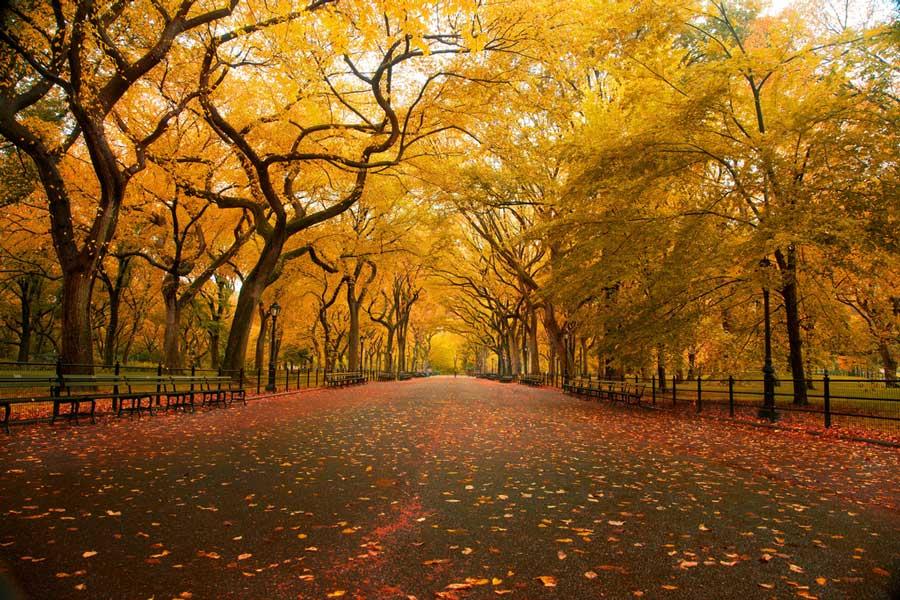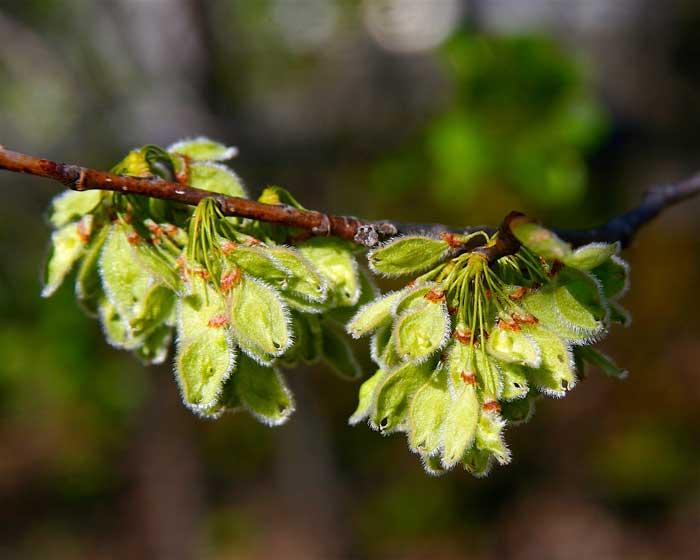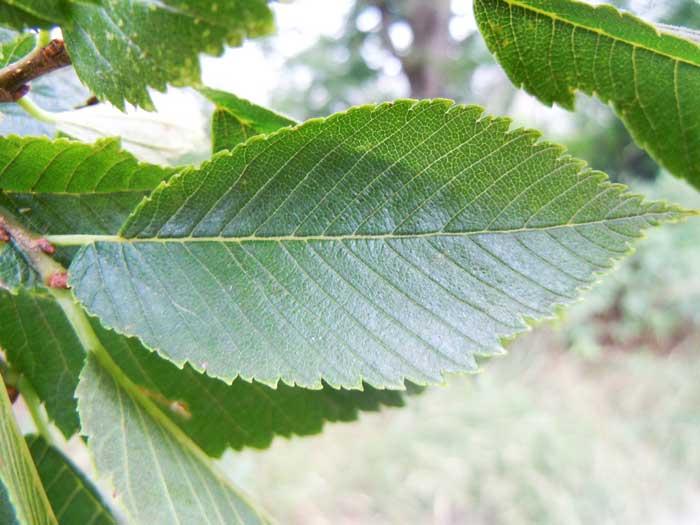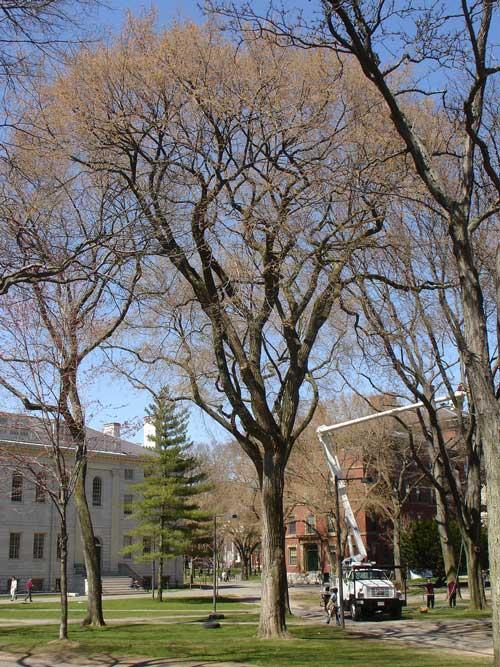Economic Botany and Cultural History: American elm
By Rob Paratley

The American elm once graced city streets, town squares, and farmsteads throughout eastern North America. Before European settlement, elms were often chosen by Native Americans as so-called council trees, serving as a signpost for significant tribal gatherings. The American elm (sometimes called white elm), or Ulmus americana, as it was named by Linnaeus, is the most graceful of form and potentially attains the largest size of all native elms. The form and stateliness of the tree has been appreciated by observers from colonial times on, including Oliver Wendell Holmes and Henry David Thoreau. Probably every eastern town had its elms, as did many tree-lined boulevards in our larger cities. Please note the past tense.
The beautiful form of the tree can begin to appear when the tree is still a sapling. Generally a fast-growing tree, the trunk often forks into two to several almost equally important limbs that angle away from the perpendicular. When mature, the tree’s form becomes a beautiful vase. Foresters report that some forms of American elm have a straight growth form when crowded by neighbors in a closed forest. The trunk may fork, but the tree canopy doesn’t have the room to fan out. The vase-shape was treasured by landscapers for their beauty; the more compact form was favored by timber harvesters. Elm wood is notable for being hard and strong, but difficult to split. It also steam-bends and has been used for hoops, barrel staves, boat keels and steam-bent furniture. The vase-form makes American elm one of the easiest trees to recognize at a distance. The upper branches arch out and the ends sweep down, creating a natural cathedral-like archway where elms were once planted as promenades. In city or town, elms reaching eighty feet in height or more were not uncommon. On best sites in a natural environment, American elm can top 100 feet.
And what are the best sites? Although it may also be fairly common in moist upland soils and will invade abandoned pastureland, American elm is most commonly found in bottomlands. Riparian corridors of major streams with rich, productive alluvial soil grew the largest specimens. Although American elm is not the most flood tolerant of our eastern trees, it has been shown to withstand inundation for perhaps a few weeks during the growing season, and several months during the dormant season. Almost never the dominant bottomland tree and never seen in pure stands, American elm nevertheless is part of several named forest types by the Society of American Foresters. A common bottomland forest in the Great Lakes region is the black ash- red maple- American elm type. The silver maple-American elm type is found in the Central Hardwoods region, and the sugarberry-American Elm-green ash type is one of several bottomland communities of Southern river courses. American elm is also found as a minor component of a number of other bottomland forest associations. The tree has a wide range in eastern North America, ranging to middle Florida and the Florida panhandle in the south, to southern Quebec and Nova Scotia in the northeast, and far into the Dakotas along major streams into the prairie states.
Aside from a modicum of flood tolerance and an ability to grow quickly in very productive soils, American elm has another important adaptation, making it competitive in riverine environments. The tree reaches reproductive maturity fairly quickly, producing seed by ten years old. Each tree sets an enormous amount of very light one-seeded samaras that can be taken far by the wind. This enables elms to reach and exploit the frequent disturbance of dynamic water courses (and makes it an able old-field tree in much of its range.) Before maturity of fruit and seed, of course, American elm must flower. It does so in very early spring, two to three weeks before leaf-out in mid-March. The flowers don’t call attention to themselves unless you know to look out for them. You’ll notice each branch has a maroonish hazy accent, the result of tens of thousands of tiny wind-pollinted flowers. In spite of having stamens and pistils in close proximity on such tiny flowers, American elm is almost completely self-sterile when field tested. After early spring flowering, fruit maturity occurs very rapidly. The samaras appear on the tree in April and are blowing in the wind and on the ground merely weeks later. American elms begin to produce a good seed crop before 20 years of age, and continue great reproductive output throughout the life of the tree. American elm was potentially a long-lived species. Many 100-200 year old elms are know and a few over 300 years have been recorded.

But, alas, mature elms have become quite scarce in our wooded and human landscapes. In 1928, a particular shipment of elm logs came from Europe destined for production of veneer in an Ohio mill. This particular shipment contained a pathogen new to North America. Previously, in 1910, Dutch tree specialists began to notice a new disease affecting Dutch elms, a commonly planted elm hybrid. By 1919 the trees’ problems were linked to an East Asian fungus. The disease took the name of the tree first victimized—Dutch elm disease. The fungus, Ophiostoma ulmi (formerly Ceratocystis ulmi), had coevolved in tandem with Asian elms. An evolutionary “stand-off” occurs when host and pathogen evolve together over a long time, and, in this case, “survival of the fittest” meant Asian elms developing effective resistance. The European elms, and to a much greater extent their American cousins, had no long-term history with the fungus and therefore no resistance, and rapidly succumb when exposed.
Meanwhile, in America in the early 20th Century, other such shipments of various materials had already delivered to our shores an insect pest that attacks elms, the European elm bark beetle. This insect, along with the native elm bark beetle, bore into elm bark, creating the perfect delivery system for the invading Ophiostoma spores. Local forestry professionals were well aware of the European elm problem and made a great effort to quarantine affected areas. But the ability to isolate the disease around, say the New York City area, proved fruitless. Diseased elms soon were noticed all over the eastern seaboard, from the storied elms of Ivy League campuses to the rural village greens of New England. American elm canopies showed yellowing & wilting leaves, with branch death and bark sloughing to follow. Tree death is the typical end-point. The fungus, using the beetle bore holes, attacks the tree’s vascular cambium. In a futile attempt to defend itself, the tree plugs up its xylem, the water-conducting system. Damaged cambium cannot forms new vascular tissue for the tree. Plugged up xylem pipes cannot deliver water to the leaves in the canopy. Both result in water-deprived leaves, a shutdown of photosynthesis, and the progression of symptoms mentioned above.

All over the Eastern and Northern U.S., people witnessed the rapid loss of mature American elms. The disease is particularly virulent in the Northeast, where the solitary isolated mature elm has become a rare site. In the South a greater number of elms seem to survive. Nevertheless, the vase-shaped skeletons of dead American elms are a common site throughout our region’s farmsteads and bottomlands. One estimate claims that some 70 million elms have been killed by the disease. Other native elms also have very poor resistance, but none can compare to the economic impact and aesthetic loss of the American elm. Many other disease and insect pests plague elms, but Dutch elm disease has had by far the most devastating effect. Elms are also easily damaged by fire. (Even bottomlands can burn in dry summers and falls.) Drought will also weaken elms, making them susceptible to pests and other problems.
Are American elms as a species becoming scarce in our landscapes? Actually not. Because the tree is such a prolific seeder at such an early age, and because the fungus doesn’t get a good foothold into the inner bark until the outer bark breaks into ridges and furrows, elm seedlings and saplings still proliferate along most water courses and fields. It is the stately, mature American elm that has become scarce.

Of course, research into disease prevention and resistance has been ongoing. Initial attempts to control the insect vector were inefficient and fraught with unintended adverse consequences to insect-eating birds . Fungicide research has been more promising. Effective fungicides might prevent and prolong the life of selected elms, but must be reapplied (root or tree base injections) periodically. The injection holes can possibly be a conduit for other pests. All sources stress sanitation, killing and removing infected trees to both impact the fungus and the breeding habitat for its beetle vectors. There has been some success with hybrids crossing American elm with resistant elms like Chinese elm. Often exotic elms are planted in its stead. A popular choice has been the Japanese zelkova, a relative in the elm family, is often planted because it assumes a vase-like habit and has roughly elm-like leaves, although it lacks the American elm’s size and grace.
Photography
- American Elm Walkway (Chris Ford, Flickr, CC)
- American Elm Seed (Dan Mullen, Flickr, CC)
- American Elm Foliage (Wikipedia Commons)
- American Elm Form (Geneva Wirth, Flickr, CC)
About the Author
Rob Paratley is an Agriculture Research Specialist in the University of Kentucky Department of Forestry and Natural Resources. Rob has taught several courses at the University of Kentucky including Taxonomy of Vascular Plants, Economic Botany, and is the Curator of the UK Herbarium. Email Rob at rparatl@uky.edu.
